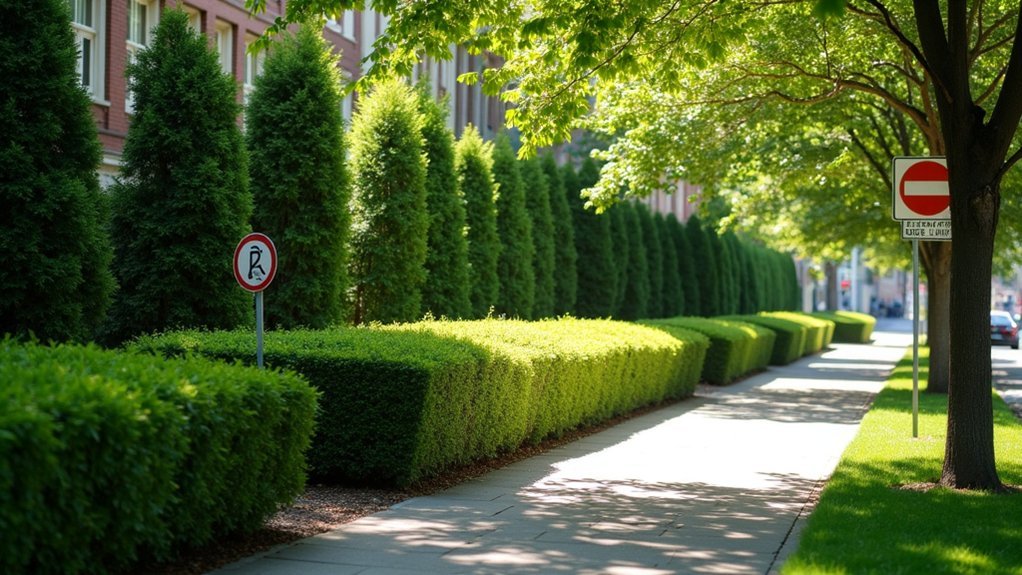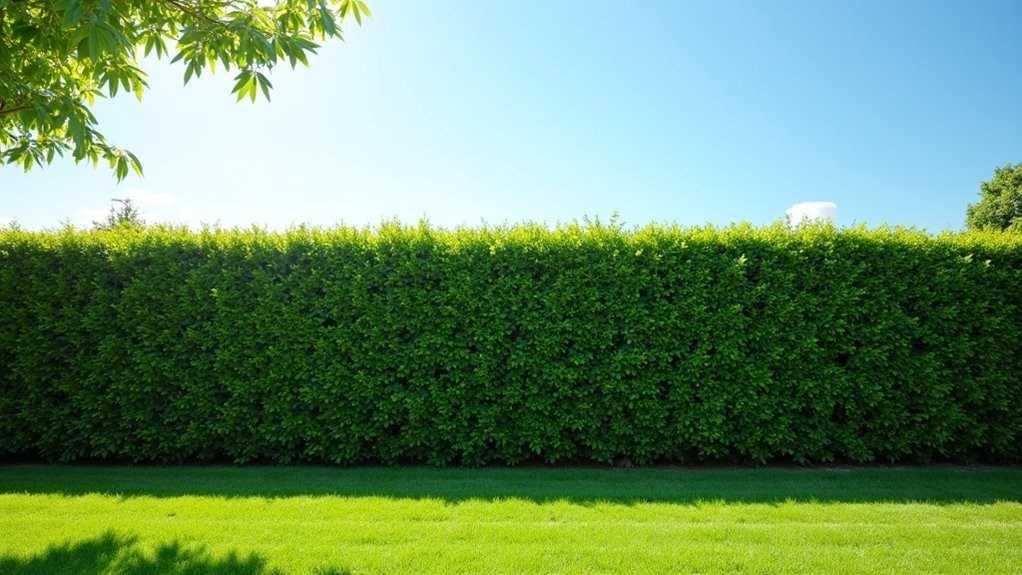Urban hedge height limits typically range from 30 inches in front yards to 6 feet along side yards and up to 8 feet in backyards. Your local municipality likely classifies hedges as “fences” when they block sightlines or mark boundaries. Height restrictions exist primarily for safety and visibility near sidewalks and driveways. Check with your city’s zoning department before significant pruning or planting. Understanding these regulations can help you avoid neighbor disputes and potential fines.
Understanding Local Hedge Height Regulations and Ordinances

While homeowners often take pride in their lush green hedges, these living boundaries come with legal restrictions that vary considerably by location.
Most municipalities enforce specific height restrictions, typically capping hedges at around 6 feet, though limits may differ between front, side, and rear property lines.
Height restrictions for hedges generally max out at 6 feet, but check your area’s rules for variations by property line position.
You’ll need to research your city’s specific ordinances, as many jurisdictions classify hedges differently from a front yard fence when applying regulations.
These height limitations aren’t arbitrary—they’re designed to maintain visibility along sidewalks and driveways, ensuring safety for pedestrians and drivers.
If your hedge exceeds legal limits, you may face enforcement actions from local authorities.
Your neighbors might also have legal recourse if your overgrown hedge obstructs views or violates municipal codes.
Determining If Your Hedge Qualifies as a “Fence” Under Municipal Law
Despite their natural appearance, many municipalities legally classify hedges as “fences” when they serve similar boundary-marking or privacy functions. To determine if your hedge falls under fence regulations, check your local municipal code for specific definitions.
When evaluating your hedge’s legal status, consider:
- Functional purpose – Hedges planted along property lines that block sightlines often qualify as fences.
- Height measurements – Many jurisdictions apply fence height restrictions (typically 4-6 feet) to hedges, especially in front yards.
- Setback requirements – Even vegetation may need to observe minimum distances from property lines and public rights-of-way.
Contact your local zoning department for clarification, as hedge regulations vary considerably between municipalities.
Don’t assume natural plantings are exempt from the restrictions that apply to traditional fencing materials.
Common Height Restrictions for Front, Side, and Backyard Hedges

Understanding a hedge’s legal classification forms the foundation for knowing the specific height limits it must observe.
Most municipalities restrict front yard hedges to 30 inches maximum to maintain visibility for pedestrians and drivers. This height limit is considerably lower than typical fence height restrictions in the same area.
For side yards, regulations commonly allow hedges to reach up to 6 feet tall, similar to standard fence height limitations.
Your back yard offers the most flexibility, with many jurisdictions permitting hedges to grow up to 8 feet without requiring special permits.
Always check your local ordinances before planting or trimming, as some cities have unique regulations that treat hedges differently from fences, potentially affecting the permitted heights in all areas of your property.
Neighbor Disputes and How to Navigate Complaint-Based Enforcement
Because most municipalities rely on complaint-based enforcement systems rather than proactive inspections, your towering hedge might never raise official concerns until a neighbor contacts local authorities.
Most cities won’t notice your overgrown hedge until someone complains—enforcement typically begins with a neighbor’s grievance, not proactive monitoring.
When disputes arise, understanding city code requirements can help you respond appropriately.
If you’re facing a hedge-related conflict:
- Document everything—take dated photos of your hedge, record any conversations with neighbors, and research your local fence height regulations
- Attempt informal resolution before authorities get involved—a friendly conversation might resolve issues without triggering formal enforcement
- Consider compromise solutions like selective trimming that satisfy both privacy needs and visibility concerns
Remember that enforcement often begins only after a formal complaint.
When neighbor disputes escalate to city enforcement, you’ll typically receive notification with a timeline for compliance before any fines are assessed.
Seeking Variances or Exceptions for Established Natural Barriers

When your cherished hedge exceeds local height restrictions, you don’t necessarily need to reach for the pruning shears right away. Many municipalities offer variance procedures for property owners seeking exceptions.
To successfully obtain a variance, you’ll need to demonstrate your hedge serves a legitimate purpose, such as privacy or noise reduction. Prepare detailed documentation showing how your natural barrier doesn’t negatively impact neighbors or create safety hazards.
Long-established hedges often receive more favorable consideration, especially if they’ve existed without complaints. Gathering support from adjacent neighbors greatly strengthens your case. Their endorsement indicates your hedge isn’t causing neighborhood discord.
Before applying, research local fence height regulations and similar approved variances. This preparation helps you craft a compelling argument that addresses specific concerns your zoning board typically evaluates when considering exceptions.
Frequently Asked Questions
What Is the Highest Fence You Can Have Between Neighbours?
You can typically build a fence between 6-8 feet high in most urban areas. You’ll need permits for anything taller, and you should check your local ordinances for specific height restrictions in your neighborhood.
What Is the Maximum Height for a Privacy Fence?
You’ll typically find privacy fences maxing out at 6-8 feet in most urban areas. Check your local regulations as some cities allow 8-foot backyard fences without permits, while others require approval above 6 feet.
Can I Have a 7 Foot Fence?
You’ll likely need a permit for a 7-foot fence, as most municipalities limit standard residential fences to 6 feet. Check your local zoning codes and consider talking with neighbors before proceeding with installation.
How Tall Can My Fence Be in Texas?
In Texas, you can build your backyard and side yard fences up to 8 feet without a permit. Your front yard fence should be 3-3.5 feet tall and needs local planning department approval.
What Is the New Law on Fences in Texas?
There’s no new statewide fence law in Texas. You’ll need to check your local municipality’s regulations, as cities like Houston have specific height limits (3-3.5ft front yard, up to 8ft backyard).
In Summary
You’ll need to check your local zoning codes as hedge height limits typically range from 3-8 feet, varying by location in your yard. Remember that established hedges might be grandfathered in, but complaint-driven enforcement means maintaining good neighbor relations is essential. If you need an exception, document privacy needs or environmental benefits when requesting a variance from your municipal planning department.





Leave a Reply